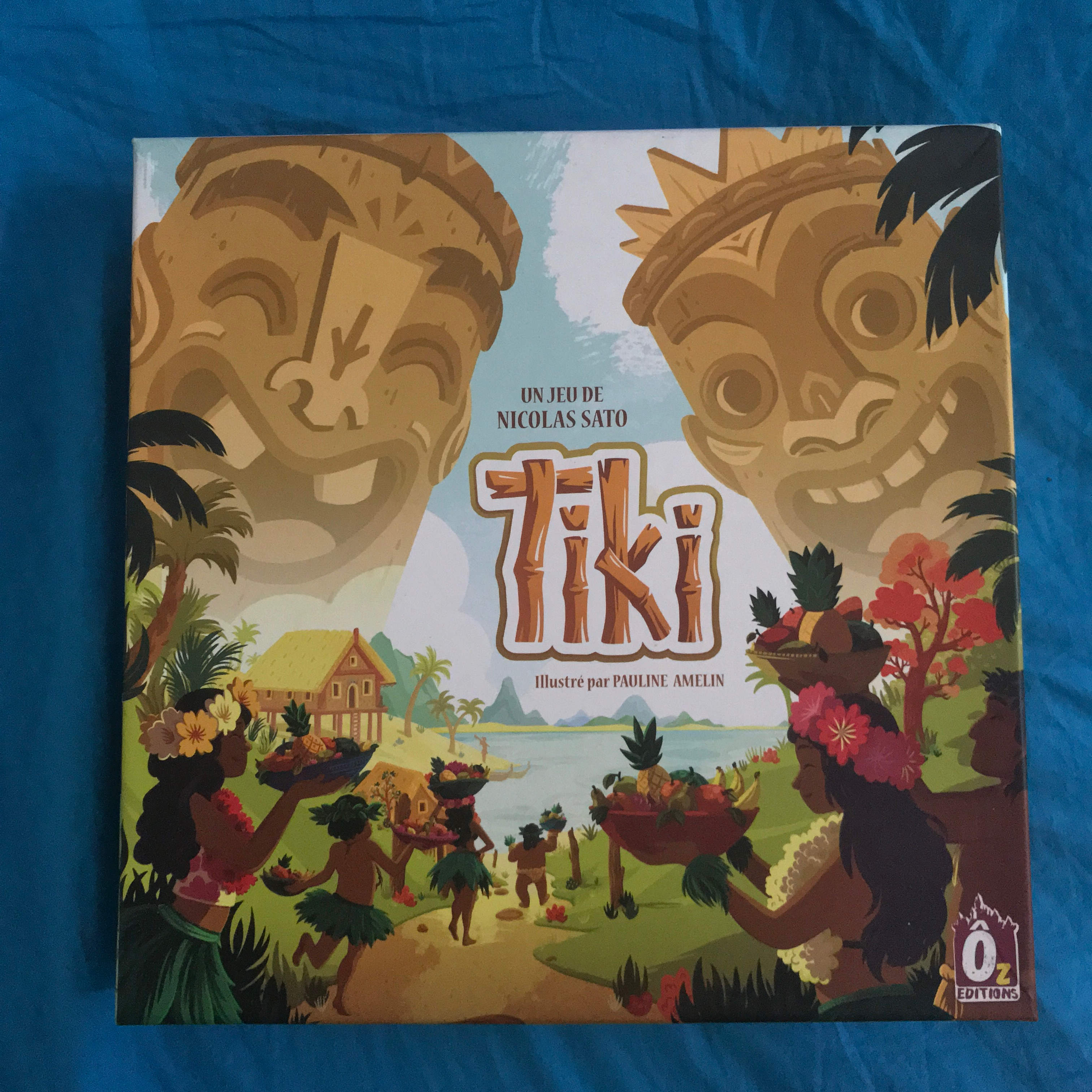I am not really fond of pineapple but when two gods in Tiki are competing for them, I think I would really give this fruit a try. Anyway, Tiki is not a game I got from Spiel Essen 2018. This game is published by OZ Editions and designed by Nicolas Sato. I saw this game when they released it through Kickstarter. Sadly, back then I forgot to back and missed it. It’s a very good ending that someone offered me this game so I can review it today.
How to play Tiki
In order to play Tiki, you have to mix all 9 village tiles and randomly place them to form a 3×3 square. Please make sure that you have the pineapples ready on the side. Do not forget to choose your god and take the corresponding 8 Tikis of its colour. It’s so simple, right? This is the first time I wrote down a game setup that does not exceed 2 lines, though!
During his/her turn, the player has to do two steps. In the first step, you can either create a totem (tiki) or move it. When you create a new totem, place one of your tiki on an empty village. If you decide to move a totem, you must take the whole totem and move it a number of villages equal to the number of tikis of that totem. Please do bear in mind that the owner of the totem is decided based on the tiki’s colour on the top of the totem. Any diagonal move is forbidden and you cannot go back and forth between tiles.
The second step is to check the influenced villages resolution. A village tile is influenced when 3 tikis pile up on it. The totem’s owner must resolve the tile. The resolution is indicated on the corner of the pile. You either get 1 or no pineaple; and you might also lose one if the cursed village is resolved!
The game ends when a player gains 4 pineapple. If the reserve is empty before it happens, then the player with the most pineapple wins the game. If there’s a tie, then do one more round until someone gets the first next pineapple.

The setup
Get used to shaman variant
Besides the standard game, Tiki also includes a variant that involves a shaman totem. In order to play this, you just have to place the shaman near the pineapple reserve and switch the marshland tiles to the shaman side. When the shaman tile is resolved, take the shaman totem and place it between two village tiles. By doing so, all moves between these two tiles are forbidden.
My experience with Tiki
The modular board makes the game different every time. When I got bored with the standard game, I would just play with the shaman variant. Without the shaman variant, Tiki has been challenging already. I also like how the players need to think and manipulate the opponent in order to lead them making mistakes. I would say the mechanic involves programming process to decide the movement between grids; you have to arrange the tikis in order to give you the best alternatives to gain the most pineapple.
Tiki is meant for 2 players only; it’s a duel between you and your opponent. It is indeed a very simple game. I managed to finish my Tiki session in approximately 10-15 minutes.
The tile that contributes 2 pineapple would be the most contested one, followed by the tile that would spoil the fruit. It was really hard to arrange the program in order to initiate this tile. If you are not careful, you might give your opponent a chance to take 1 pineapple from other tiles. My experience was a mixed sensation between programming a movement flow and playing an actual board game. There’s a logic behind the movement of the totems.
The standard game relies heavily on your opponent’s miscalculation. You do not want to form a totem with 2 tikis on the tiles with 2 pineapples when your opponent’s tikis are surrounding it; he/she might steal it before you can resolve the tile. We tried the game with the shaman variant and it was getting more intense. You can somehow prevent your opponent’s tikis to annoy your movement you have set up; or you can even force them to go around the tiles to give them disadvantage.
Final thoughts
Tiki is a very simple and easy-to-learn abstract game for 2 players. The tiles to build the board means it is modular and always changing. If you have a very limited time and space, Tiki will be a very good addition to your arsenal. As I mentioned before, it’s a simple game that might not be interesting for gamers who seek for something more complex.
The component is an absolute beauty. Your Tiki is not a mere cardboard; they formed it so solid you might think it was made of stone. I got the Kickstarter version, so they also make the deluxe version for the pineapple and the shaman.
I would say that you should play the standard game a few times before you go for the shaman variant. In fact, I think the standard one is actually just a tutorial before you involve the shaman because it gives more strategic appeal to Tiki. Without the shaman, the game would easily make you bored.
Because of it simple nature, Tiki might not offer a longevity. I felt that it was a bit too repetitive despite the always-changing modular boards; you plan your movement and ‘program’ the flow over and over. Nevertheless, this game is actually a very good abstract game for your filler. It would be interesting if the publisher and designer decide to draft the expansion for more player counts!
I am a full-time food technologist during weekdays. However, when the calendar hits weekends, I transform into an avid board gamer. I am a hardcore Legend of the Five Rings (L5R) LCG player from Fantasy Flight Games (FFG). Current hobby: buying board games. My shelf of shame’s list is getting longer, thanks to you, Kickstarter.










